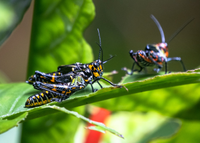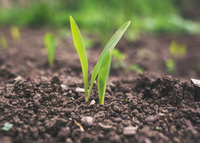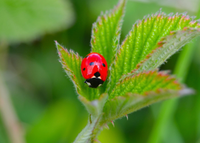The solution to managing pests through climate change is found in taking care of plants’ lines of defense—the soil that feeds them
From cabbage loopers to squash bugs to tomato hornworms and everything in between, pests can be a real deterrent for gardeners. It can feel like no matter what you do, these little critters come and decimate the crop you've worked so hard to cultivate.
In these moments, it can feel tempting to use pesticides, herbicides, insecticides and other sprays to keep the pests at bay, but by doing this, you may actually be adding to the problem in the long term. Unfortunately, pests will continue to worsen as our climate changes, but there are ways to work with nature rather than against it in our pursuit of growing food.
How climate change and pests are linked Photo by Dimitry B on Unsplash
Photo by Dimitry B on Unsplash
Since the invention of modern agriculture, we’ve been trying to battle diseases, pests and anything that stands in our way of growing food for mass populations. Industrial agriculture tried to overcome these challenges with GMO seeds, chemical sprays and other ways of manipulating food growth to feed and sustain us. Yet, somehow, pests continue to multiply faster and are predicted to do so more as our climate warms, which will inevitably disrupt our worldwide food production and leave even more people food insecure. So, why are pests thriving as our climate changes?
Pests thrive in warmer locations with increased precipitation. As our atmosphere warms, which speeds up evaporation, and leads to extreme weather patterns like hurricanes and rainstorms, it has cultivated a breeding ground for garden pests. As they multiply and sweep through areas until there’s no food left behind, they go on searching for new sources of food outside of their normal locations. And when those insect populations migrate from tropical locations, they bring diseases with them.
The continued warming of our planet also allows bacteria to thrive and these diseases can be carried further than if the climate was stabilized, meaning that they can affect more crops worldwide in both personal gardens and in agricultural settings. Our response to this increase in pests has been an extended use of pesticides and fertilizers, which helps to eliminate pests while also enhancing crop productions. But as easy as this solution has seemed, it has been a band-aid solution that has unraveled and led to further climate destruction.
Pesticides don’t just harm pests, they also attack the beneficial insects and the life that creates a healthy, thriving soil ecosystem. Having an impaired soil ecosystem is like taking a shot to the earth’s immune system: it is left with very little energy to fight back when an illness or disease arrives with that migrating pest.
With the pesticide trend increasing, we’re seeing harm to the health of our natural habitats in destroyed biodiversity, a polluted marine environment, reduced bee populations and more. We’ve also seen food insecurity and malnutrition at an all-time high, so there’s clearly something missing in our farming efforts.
What’s missing is working directly with the soil—to regenerate it, to rebuild and strengthen it—which will allow our plants the resources and strength to fight back when threatened with an abundance of pests.
Gardeners and farmers can make a difference Photo by Roman Synkevych 🇺🇦 on Unsplash
Photo by Roman Synkevych 🇺🇦 on Unsplash
As sustainable growers put out research and studies on the benefits of soil health for human and planetary health—and also for the long-term success of food growth and production—we’ve been seeing more farmers and gardeners take an interest in their soil.
By beginning to rebuild biodiversity and function in the soil through sustainable management methods, like the use of crop rotations, cover crops and no-till practices, growers are seeing more vibrant and vigorous plants which are able to resist pests and pathogens. This bodes well for the future of agriculture as we continue to see the increase in pests in various areas, and shows promise towards working with the environment in our agricultural endeavours, rather than continuing to degrade it.
Once the soil ecosystem regulates itself and returns to balance, plants can begin to feed themselves with the proper nutrients. Then, when the plants have the proper nutrients and defense systems in line, we can watch our gardens and farms thrive with delicious and nutritious food for all.
Working with soil through organic pest management is just as important in gardens as it is on larger-scale farms, as every bit of soil that isn’t being sprayed or tilled is a safe haven for beneficial insects, biodiversity and soil ecology to reestablish themselves. Here are some tips on how to grow food organically while helping your garden’s ecosystem regulate and thrive.
Sustainable pest management tips Photo by Sander on Unsplash
Photo by Sander on Unsplash
- Plant the right “food”: No, not just for yourself, but for beneficial insects as well. There are strategies to enhance beneficial insects from the get-go, such as planting certain flowering crops (nasturtiums or marigolds) that will attract insects (ladybugs) that will then prey on pests (mites and aphids).
- Plant trap crops: Perimeter trap-cropping uses crops that are especially attractive to target pests and encircling it around the wanted crop. For example, planting Blue Hubbard squash near cucumbers draws cucumber beetles away from the “cash crop” of cucumbers. It’s important to check your trap crop often to get rid of the insects before they run out of food and migrate to your wanted crop.
- Plant deterrents: Interplanting or companion-planting tomato beds with basil, and cilantro or peppers with parsley, will help keep pests away by deterring them with strong-smelling herbs. Other herbs, such as sage, rosemary, marjoram, thyme and oregano also have powerful scents, which turn pests away from your crop, while also flowering and attracting those beneficial predatory insects yet again.
- Mow infrequently: Studies have shown that mowing the lawn once a month versus weekly increases habitats for beneficial insects. Having food available for beneficial insects is only one step, but taking it to the next level by having safe spaces around your yard for them to rest or overwinter increases the likelihood that they will stick around for the long run.
- Plant a variety: Inevitably, as you’re beginning your organic-growing journey, pests will come and possibly destroy your crop. This happens! It takes time for the predators to recognize that there is food in your garden and zero in on it. Until then, plant a variety, and plant in multiple spots around your yard so that you don’t lose all of your crops. Insect covers and netting also work wonders in the meantime.
- Enhance your soil: The main takeaway here is to enhance plants’ defenses against pests through soil management, and that’s easily done by noticing what it is your soil is needing. Certain weeds can tell you what your soil is missing, and imbalances can be rectified by applying compost, worm castings, natural fertilizers, like worm or plant “teas”, mulch, and a rotation of plants supplying a variety of nutrients. A biologically healthy soil is complex and can take time to diagnose and regulate, but don’t get discouraged! You can read more about healthy soil on page 65 of this document.
Everything is connected—and we can’t alter one thing in nature without causing a chain reaction. So much of gardening and farming is in the art of letting go, which can be challenging when we’re relying on food to live and thrive. The important thing to note here is that everything in Mother Nature is also self-correcting. She knows how to heal herself, and we’re just meant to be guides in the journey to sustainably growing and harvesting food. Pests will come and go, and we need to learn when it’s a time to manage them organically, and when it’s a time to learn that some things are out of our control.



